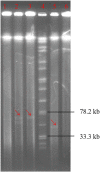Plasmid-Assisted Horizontal Transfer of a Large lsa(E)-Carrying Genomic Island in Enterococcus faecalis
- PMID: 35863017
- PMCID: PMC9430800
- DOI: 10.1128/spectrum.00154-22
Plasmid-Assisted Horizontal Transfer of a Large lsa(E)-Carrying Genomic Island in Enterococcus faecalis
Abstract
The horizontal transfer of genomic islands is essential for the adaptation and evolution of Enterococcus faecalis. In this study, three porcine E. faecalis strains, each harboring a large lsa(E)-carrying genomic island, were identified. When using the E. faecalis OG1RF as the recipient, the horizontal transfer of the lsa(E)-carrying genomic island occurred only from E. faecalis E512, which also harbored a pheromone-responsive conjugative plasmid, but not from the other two E. faecalis strains, E533 and E509, which lacked such a plasmid. Subsequently, through plasmid curing of E. faecalis E512 and plasmid introduction into E. faecalis E533, the pheromone-responsive conjugative plasmid was identified to be indispensable for the horizontal transfer of the lsa(E)-carrying genomic island and a subsequent homologous recombination between the chromosomal DNA of the donor and the recipient. In addition, the presence of a chromosomally-located conjugative transposon, Tn916, in E. faecalis E509 could not mediate the horizontal transfer of the lsa(E)-carrying genomic island, although Tn916 itself could transfer by conjugation. Thus, these data highlight the role of the pheromone-responsive conjugative plasmid in the transfer of the lsa(E)-carrying genomic island in E. faecalis, thereby establishing the dual role of pheromone-responsive conjugative plasmids in contributing to the dissemination of both plasmid-borne resistance genes and chromosomally-located genomic islands. IMPORTANCE In this study, it was shown that a pheromone-responsive conjugative plasmid played an indispensable role in the horizontal transfer of a lsa(E)-carrying genomic island. This finding indicates a dual role of the pheromone-responsive conjugative plasmid in disseminating both plasmid-borne resistance genes and chromosomally-located genomic islands. The role of the pheromone-responsive conjugative plasmid in disseminating chromosomal genomic islands is suggested to be essential in the genomic evolution of E. faecalis, which has become one of the leading nosocomial pathogens worldwide.
Keywords: Enterococcus faecalis; Tn916; conjugative plasmids; genomic island; horizontal transfer.
Conflict of interest statement
The authors declare no conflict of interest.
Figures




Similar articles
-
Linezolid-Resistant Enterococcus faecalis of Chicken Origin Harbored Chromosome-Borne optrA and Plasmid-Borne cfr, cfr(D), and poxtA2 Genes.Microbiol Spectr. 2023 Jun 15;11(3):e0274122. doi: 10.1128/spectrum.02741-22. Epub 2023 Mar 30. Microbiol Spectr. 2023. PMID: 36995237 Free PMC article.
-
Probiotic Bacillus Affects Enterococcus faecalis Antibiotic Resistance Transfer by Interfering with Pheromone Signaling Cascades.Appl Environ Microbiol. 2021 Jun 11;87(13):e0044221. doi: 10.1128/AEM.00442-21. Epub 2021 Jun 11. Appl Environ Microbiol. 2021. PMID: 33893118 Free PMC article.
-
Enterococcus faecalis Sex Pheromone cCF10 Enhances Conjugative Plasmid Transfer In Vivo.mBio. 2018 Feb 13;9(1):e00037-18. doi: 10.1128/mBio.00037-18. mBio. 2018. PMID: 29440568 Free PMC article.
-
The sex pheromone system of Enterococcus faecalis. More than just a plasmid-collection mechanism?Eur J Biochem. 1994 Jun 1;222(2):235-46. doi: 10.1111/j.1432-1033.1994.tb18862.x. Eur J Biochem. 1994. PMID: 8020463 Review.
-
Peptide pheromone-induced transfer of plasmid pCF10 in Enterococcus faecalis: probing the genetic and molecular basis for specificity of the pheromone response.Peptides. 2001 Oct;22(10):1529-39. doi: 10.1016/s0196-9781(01)00489-2. Peptides. 2001. PMID: 11587782 Review.
Cited by
-
Pheromone Activity after Stimulation with Ampicillin in a Plasmid-Free Enterococcus faecalis Strain.Microorganisms. 2022 Nov 19;10(11):2294. doi: 10.3390/microorganisms10112294. Microorganisms. 2022. PMID: 36422364 Free PMC article.
-
Recent development and fighting strategies for lincosamide antibiotic resistance.Clin Microbiol Rev. 2024 Jun 13;37(2):e0016123. doi: 10.1128/cmr.00161-23. Epub 2024 Apr 18. Clin Microbiol Rev. 2024. PMID: 38634634 Free PMC article. Review.
-
Genetic characterization of MDR genomic elements carrying two aac(6')-aph(2″) genes in feline-derived clinical Enterococcus faecalis isolate.Front Microbiol. 2023 Jul 27;14:1191837. doi: 10.3389/fmicb.2023.1191837. eCollection 2023. Front Microbiol. 2023. PMID: 37577435 Free PMC article.
References
-
- Sood S, Malhotra M, Das BK, Kapil A. 2008. Enterococcal infections & antimicrobial resistance. Indian J Med Res 128:111–121. - PubMed
Publication types
MeSH terms
Substances
LinkOut - more resources
Full Text Sources
Molecular Biology Databases

